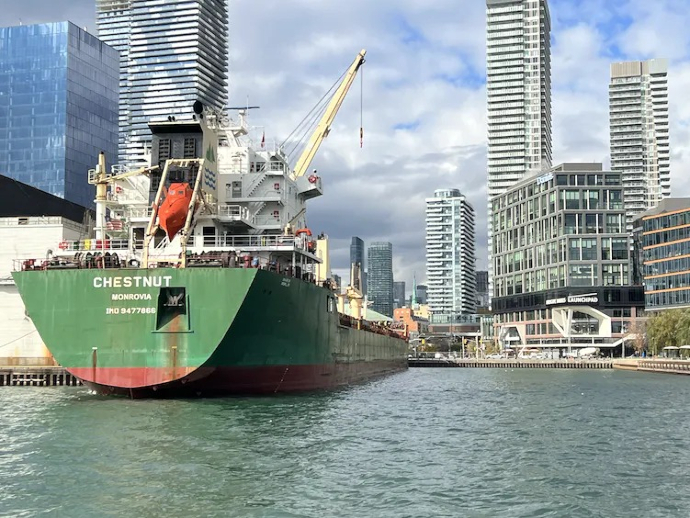A bulk cargo carrier transporting sugar docked in downtown Toronto in October 2022. Phoro by J. Rozdilsky.
Gordon Lightfoot’s music raised awareness of Great Lakes maritime disasters
by Jack L. Rozdilsky, York University, Canada
On May 1, the 84-year-old Canadian folk music icon Gordon Lightfoot died at Toronto’s Sunnybrook Hospital. Prime Minister Justin Trudeau commented that Lightfoot’s legacy will live on in the dynamic Canadian soundscape he helped to shape.
In his over 500 songs, Lightfoot was one of Canada’s most beloved chroniclers. Upon his death, we can reflect on Lightfoot’s many impacts on Canadian culture and society.
Music chronicles
One small aspect of Lightfoot’s broader impact was his skill as a purveyor of the popular culture of disaster through music.
One of his most recognized songs was the Wreck of the Edmund Fitzgerald. That 1976 folk ballad was a six-minute documentarian’s song about a tragic 1970s Great Lakes shipwreck disaster.
‘Wreck of the Edmund Fitzgerald,’ by Gordon Lightfoot.
Lightfoot’s work popularized the Great Lakes bulk cargo shipping transport disaster through song, bringing the story of the wreck of the Edmund Fitzgerald to millions of music fans. Without the song, that specific maritime disaster would not be as well known and might have faded into obscurity.
Lightfoot’s disaster music
Lightfoot is one of many Canadian musicians, albeit the most popular, who has carried forward the tradition of Canadian folk music providing a reliable narrative about disasters. Lightfoot’s contributions to disaster music include a well known and a lesser known ballad about contemporary shipwrecks, along with a song about a civil disturbance.
On Nov. 13, 1965, the SS Yarmouth Castle caught fire and sank, killing 90 people while en route from Florida to the Bahamas. The passenger ship — built in 1927 — had a wood superstructure making it dangerously susceptible to fire. In 1969, Lightfoot’s the Ballad of Yarmouth Castle detailed that maritime tragedy.
‘Ballad of Yarmouth Castle,’ by Gordon Lightfoot.
In June 1967, a police raid on an unlicensed bar triggered a series of racial grievances, leading to the Detroit Uprising. From the Canada side of the international border along the Detroit River, Windsorites lined the waterfront and watched the riot from afar as Detroit burned.
In his 1968 song, Black Day in July Lightfoot memorialized the civil disturbance with his music.
‘Black Day in July,’ by Gordon Lightfoot.
On Nov. 10, 1975, the SS Edmund Fitzgerald broke apart during a Lake Superior storm killing 29 sailors. Lightfoot was inspired to write the Wreck of the Edmund Fitzgerald after reading an article in Newsweek called “Great Lakes: The Cruellest Month.”
This song was by far Lightfoot’s most popular disaster song. While he took some artistic licence describing the shipwreck, the song was factual and timely.
A special role
Lightfoot had a special role in contributing to the legend of the Edmund Fitzgerald. In a 2010 interview, he said of the hundreds of songs that he has written, he was most proud of that 1970s shipwreck song.
The Great Lakes Shipwreck Museum at Whitefish Point, Mich., holds artifacts retrieved from depths of the Canadian portion of Lake Superior, including the Edmund Fitzgerald’s bell. The museum’s director stated that if it was not for Lightfoot’s song, awareness of the Edmund Fitzgerald would not be what it is now.
There is scant public awareness that historically 6,000 vessels have sunk in the Great Lakes, causing an estimated 30,000 deaths.
Lightfoot’s song also highlighted the role of Great Lakes shipping, which is taken for granted. Even in present day downtown Toronto, one can witness the unexpected sight of a bulk sugar carrier arriving from South America.
Bulk cargo carriers — servicing the North American industrial and agricultural heartland via the Great Lakes and St. Lawrence Seaway System — contribute to the $45 billion in economic activity from water transportation activities.
Increased awareness
While shipwreck disasters in the Great Lakes are not frequent, bulk transport by lake is not risk-free. Lightfoot’s ballad highlights the fact that Great Lakes shipwrecks are not only events of the distant past, but they also can have significant human costs in modern times.
In addition to artistic merit, entertainment value, or adding to the list of Canadian disaster songs, Lightfoot’s contribution to increased public awareness of Great Lakes maritime disaster risk is invaluable.
So significant was his contribution that, upon his death, Detroit’s Maritime Church rang its bell in memorium. In the ceremony, the bell rang 30 times: one chime for each of the 29 sailors lost on the Edmund Fitzgerald, and one additional chime to honour the life and legacy of Lightfoot.![]()
Jack L. Rozdilsky, Associate Professor of Disaster and Emergency Management, York University, Canada
This article is republished from The Conversation under a Creative Commons license. Read the original article.
Contact us by email at fund4thepanamanews@gmail.com
To fend off hackers, organized trolls and other online vandalism, our website comments feature is switched off. Instead, come to our Facebook page to join in the discussion.
These links are interactive — click on the boxes












